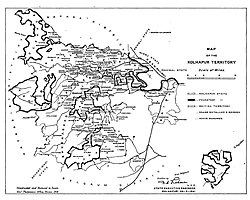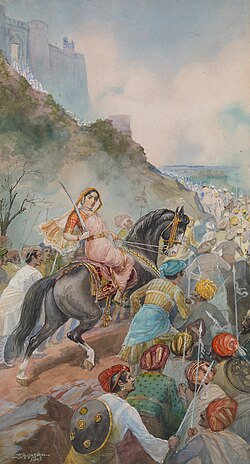Kolhapur State
Kolhapur State or Kolhapur Kingdom (1710–1949) was a Maratha princely State of India, under the Deccan Division of the Bombay Presidency, and later the Deccan States Agency.[1] It was considered the most important of the Maratha principalities with the others being Baroda State, Gwalior State and Indore State. Its rulers, of the Bhonsle dynasty, were entitled to a 19-gun salute – thus Kolhapur was also known as a 19-gun state. The state flag was a swallow-tailed saffron pennant.[2]
| Kolhapur State | |||||||||
|---|---|---|---|---|---|---|---|---|---|
| Princely state of British India | |||||||||
| 1710–1 Mar 1949 | |||||||||
 Kolhapur State Map, 1912 | |||||||||
| Capital | Kolhapur | ||||||||
| Area | |||||||||
• 1901 | 8,332 km2 (3,217 sq mi) | ||||||||
| Population | |||||||||
• 1901 | 910,011 | ||||||||
| History | |||||||||
| History | |||||||||
• Established | 1710 | ||||||||
• Acceded to Dominion of India | 1947 | ||||||||
• Merged into Bombay State | 1 Mar 1949 | ||||||||
| |||||||||
| Today part of | Maharashtra, India | ||||||||


Kolhapur State, together with its jagirs or feudatory vassal estates (including Ichalkaranji), covered an area of 3,165 square miles (8,200 km2).[3] According to the 1901 census, the state population was 910,011, of which 54,373 resided in Kolhapur Town. In 1901, the state enjoyed an estimated revenue of £300,000.[3][4]
HistoryEdit
This section needs additional citations for verification. (March 2010) |
The Maharajas of Kolhapur have a common ancestry with the Bhonsle dynasty of Satara, being direct descendants of the Maratha King Shivaji. The states of Satara and Kolhapur came into being in 1707, because of the succession dispute over the Maratha kingship. Shahuji, the heir apparent to the Maratha kingdom, captured by the Mughals at the age of nine, remained their prisoner at the death of his father Sambhaji, the elder son of Shivaji the founder of the Maratha Empire, in 1689. The Dowager Maharani Tarabai (wife of Rajaram I) proclaimed her son Shivaji II, as Chhatrapati under her regency. The Mughals released Shahu under certain conditions in 1707, and he returned to claim his inheritance. He defeated the regent at the Battle of Khed and established himself at Satara, forcing her to retire with her son to Kolhapur. By 1710 two separate principalities had become an established fact. Shivaji II and Tarabai were soon deposed by the other wife of Rajaram, Rajasbai. She installed her own son, Sambhaji II as the new ruler of Kolhapur. Sambhaji II signed the Treaty of Warana in 1731 with his cousin Shahuji to formalize the two separate seats of Bhonsle family. The British sent expeditions against Kolhapur in 1765 and 1792;[3] Kolhapur entered into treaty relations with the British, after the collapse of the Maratha confederacy in 1812. In the early years of the 19th century the British invaded again, and appointed a political officer to temporarily manage the state.[3][5]
A regent called Daji Krishna Pandit was installed by the British to govern the state in 1843 at a time when the natural heir to the throne was underage. He took direction from a political agent of the East India Company and among their actions were reforms to the tax of land. These reforms caused much resentment and, despite Kolhapur having refrained from involvement in the previous Anglo-Maratha Wars, a revolt against the British began in 1844. The rebellion began with soldiers locking themselves into hill-forts such as those as Panhala and Vishalgad, and then spread to Kolhapur itself. Both the regent and the political agent were captured by the militia forces led by Babaji Ahirekar.[6]
The last ruler of Kolhapur was Maharaja Shahaji II. After Indian independence in 1947, Kolhapur acceded to the Dominion of India on 14 August 1947 and merged into Bombay State on 1 March 1949. In 1960 Bombay state was divided by languages into the states of Maharashtra and Gujarat.[citation needed] The boundaries of former Kolhapur state correspond very closely with those of modern-day Kolhapur district in Maharashtra state.
Rulers of KolhapurEdit
RajasEdit
- 1710 – 2 Aug 1714 Shivaji II (b. 1696 – d. 1726)
- 2 Aug 1714 – 18 Dec 1760 Sambhaji II (b. 1698 – d. 1760)
- 20 Dec 1760 – 17 Feb 1773 Rani Jiji Bai (f) – Regent(b. 1716 – d. 1773)
- 22 Sep 1762 – 24 Apr 1813 Shivaji III(b. 1756 – d. 1813)
- 24 Apr 1813 – 2 Jul 1821 Sambhaji III (b. 1801 – d. 1821)
- 2 Jul 1821 – 3 Jan 1822 Shivaji IV (b. 1816 – d. 1822)
- 2 Jul 1821 – 3 Jan 1822 Shahaji -Regent (b. 1802 – d. 1838)
- 3 Jan 1822 – 29 Nov 1838 Shahaji
- 29 Nov 1838 – 4 Aug 1866 Shivaji V (b. 1830 – d. 1866)
- 29 Nov 1838 – 1845 Rani Sai Bai (f) -Regent (d. 1861)
- 4 Aug 1866 – 30 Nov 1870 Rajaram II Nagaji Rao (b. 1850 – d. 1870)
- 30 Nov 1870 – 12 Oct 1871 Rani Tara Bai (f) – Regent (b. 1855 – d. 1874)
- 12 Oct 1871 – 25 Dec 1883 Shivaji VI Chhatrapati Narayana Rao (b. 1863 – d. 1883)
- 25 Dec 1883 – 17 Mar 1884 Rani Anand Bai (f) – Regent
- 17 Mar 1884 – 1900 Shahu Chhatrapati Jashwant (b. 1874 – see below)
MaharajasEdit
- 17 Mar 1884 – 20 Mar 1885 Jaisinhrao Ghatge - Regent
- 1900 – 6 May 1922 Shahu Chhatrapati (see above; d. 1922)
- 6 May 1922 – 26 Nov 1940 Rajaram III Chhatrapati (b. 1897 – d. 1940)
- 26 Nov 1940 – 18 Nov 1942 Tara Bai (f) -Regent (1st time) (b. 1904 – d. ....)
- 18 Nov 1942 – 28 Sep 1946 Shivaji VII Chhatrapati (b. 1941 – d. 1946)
- 22 Nov 1942 – 31 Mar 1947 Tara Bai (f) -Regent (2nd time) (s.a.)
- 31 Mar 1947 – 14 Aug 1947 Shahaji II Chhatrapati (b. 1910 – d. 1983)
Titular MaharajasEdit
- 15 Aug 1947 – 9 May 1983 Shahaji II
- 1983 – present Shahu II
Family treeEdit
- Babaaji Bhonsle
- Template:Tree list/final branch Maloji Bhosale (1552–1606/20/22)
- Shahaji Bhonsle (c.1594–1664)
- Template:Tree list/final branch SHIVAJI The king of the Maratha Kingdom (c.1630–1680; Emperor: 1674–1680)
- Sambhaji, King of the Maratha kingdom (1657–1689; r. 1680–1689)
- Template:Tree list/final branch Rajaram, King of the Maratha Kingdom (1670–1700; r. 1689–1700)
- I. Shivaji II, Raja of Kolhapur (1696–1726; Raja of Kolhapur: 1710–1714)
- Template:Tree list/final branch II. Sambhaji II, Raja of Kolhapur (1698–1760; r. 1714–1760)
- Template:Tree list/final branch SHIVAJI The king of the Maratha Kingdom (c.1630–1680; Emperor: 1674–1680)
- Template:Tree list/final branch Sharifjirao
- Template:Tree list/final branch Trimbukjirao
- Template:Tree list/final branch Venkatjirao
- Template:Tree list/final branch Mankojirao
- Template:Tree list/final branch Shahajirao
- III. Shivaji III, Raja of Kolhapur (1756–1813; r. 1762–1813)
- IV. Sambhaji III, Raja of Kolhapur (1801–1821; r. 1813–1821)
- Template:Tree list/final branch V. Shivaji IV, Raja of Kolhapur (1816–1822; r. 1821–1822)
- Template:Tree list/final branch VI. Shahaji I, Raja of Kolhapur (1802–1838; r. 1822–1838)
- VII. Shivaji V, Raja of Kolhapur KCSI (1830–1866; r. 1838–1866)
- Shrimati Akhand Soubhagyavati Aubai Patankar m. (1845) Shrimant Sardar Ramchandrarao Patankar, Patil of Patan
- Template:Tree list/final branch VIII. Rajaram II, Raja of Kolhapur (1850–1870; r. 1866–1870)
- Template:Tree list/final branch Shrimati Akhand Soubhagyavati Balabai Maharaj Ghatge (d. 1867), m. (1848) Meherban Shrimant Chiranjiva Rajashri Narayanrao Ghatge, Sarjerao, Chief of Kagal Junior (c. 1833–1881)
- Template:Tree list/final branch HH Meherban Shrimant Rajamanya Rajashri Jaisinhrao Ghatge, Sarjerao, Vazarat, Ma-ab, Chief of Kagal Senior (1857–1885) m. (2nd; 1878) Shrimant Akhand Soubhagyavati Radhabai Sahib Ghatge
- Template:Tree list/final branch X. Shahu I, Maharaja of Kolhapur GCSI, GCIE, GCVO (1874–1922; r. 1884–1922; Raja of Kolhapur: 1884; Maharaja of Kolhapur: 1900)
- HH Shrimant Akhand Soubhagyavati Maharani Radhabai Maharaj Puar, Maharani of Dewas Senior (1894–1973) m. (1908) HH Tukojirao III, Maharaja of Dewas Senior KCSI (1888–1937)
- Template:Tree list/final branch XIII. Shahaji II, Maharaja of Dewas Senior, Maharaja of Kolhapur GCSI (1910–1983; Maharaja of Dewas Senior: 1937–1947; Maharaja of Kolhapur: 1947–1949; titular ruler: 1949–1971; family head: 1971–1983)
- Template:Tree list/final branch Shrimant Akhand Soubhagyavati Maharajkumari Shaliniraje Sahib Maharaj Bhonsle (b. 1929) m. (1945) Shrijut Raje Rajaramsinhrao Laxmanrao Bhonsle (d. 1970)
- Template:Tree list/final branch XIV. Shahu II, Maharaja of Kolhapur (b. 1948; family head: 1983–present)
- Template:Tree list/final branch Shrimant Akhand Soubhagyavati Maharajkumari Shaliniraje Sahib Maharaj Bhonsle (b. 1929) m. (1945) Shrijut Raje Rajaramsinhrao Laxmanrao Bhonsle (d. 1970)
- Template:Tree list/final branch XIII. Shahaji II, Maharaja of Dewas Senior, Maharaja of Kolhapur GCSI (1910–1983; Maharaja of Dewas Senior: 1937–1947; Maharaja of Kolhapur: 1947–1949; titular ruler: 1949–1971; family head: 1971–1983)
- Template:Tree list/final branch XI. Rajaram III, Maharaja of Kolhapur GCSI, GCIE (1897–1940; r. 1922–1940)
- HH Shrimant Akhand Soubhagyavati Maharani Radhabai Maharaj Puar, Maharani of Dewas Senior (1894–1973) m. (1908) HH Tukojirao III, Maharaja of Dewas Senior KCSI (1888–1937)
- Template:Tree list/final branch X. Shahu I, Maharaja of Kolhapur GCSI, GCIE, GCVO (1874–1922; r. 1884–1922; Raja of Kolhapur: 1884; Maharaja of Kolhapur: 1900)
- Template:Tree list/final branch HH Meherban Shrimant Rajamanya Rajashri Jaisinhrao Ghatge, Sarjerao, Vazarat, Ma-ab, Chief of Kagal Senior (1857–1885) m. (2nd; 1878) Shrimant Akhand Soubhagyavati Radhabai Sahib Ghatge
- IV. Sambhaji III, Raja of Kolhapur (1801–1821; r. 1813–1821)
- Sambhajirao
- Template:Tree list/final branch Ramchandrarao
- Template:Tree list/final branch Narayanjirao
- Template:Tree list/final branch Dinkarrao (b. 1832)
- Template:Tree list/final branch IX. Shivaji VI, Raja of Kolhapur KCSI (1863-1883; r. 1871-1883)
- Template:Tree list/final branch Dinkarrao (b. 1832)
- Template:Tree list/final branch Narayanjirao
- Template:Tree list/final branch Ramchandrarao
- Template:Tree list/final branch Swarupjirao
- Template:Tree list/final branch Mankojirao
- Template:Tree list/final branch Yashwantrao (1832–1884)
- Template:Tree list/final branch Appa Sahib
- Template:Tree list/final branch Shivajirao
- Template:Tree list/final branch Shankarrao (b. 1922)
- Template:Tree list/final branch XII. Shivaji VII, Maharaja of Kolhapur (1941–1946; r. 1941–1946)
- Template:Tree list/final branch Shankarrao (b. 1922)
- Template:Tree list/final branch Shivajirao
- Template:Tree list/final branch Appa Sahib
- Template:Tree list/final branch Yashwantrao (1832–1884)
- Template:Tree list/final branch Mankojirao
- III. Shivaji III, Raja of Kolhapur (1756–1813; r. 1762–1813)
- Template:Tree list/final branch Shahajirao
- Template:Tree list/final branch Mankojirao
- Template:Tree list/final branch Venkatjirao
- Template:Tree list/final branch Trimbukjirao
- Shahaji Bhonsle (c.1594–1664)
- Template:Tree list/final branch Maloji Bhosale (1552–1606/20/22)
Feudatory JagirsEdit
There were Eleven Feudatory Jagirdars of Kolhapur. They all paid Nazar on succession equal to a year's net income of their Jagirs and also an annual contribution towards the maintenance of military force. They are:[7]
- Vishalgad
- Bavda
- Kagal (Senior)
- Kagal (Junior)
- Kapshi
- Torgal
- Ichalkaranji
- Himmat Bahadur
- SarLashkar Bahadur
- Shahi Sarnobat
- Raovishvasrao
See alsoEdit
ReferencesEdit
- ↑ "Kolhapur State". The Imperial Gazetteer of India, Vol. 15. Oxford at Clarendon Press. 1909. pp. 380–87.
- ↑ Gazetteer, p. 380
- ↑ 3.0 3.1 3.2 3.3 Chisholm, Hugh, ed. (1911). . Encyclopædia Britannica. Vol. 15 (11th ed.). Cambridge University Press. p. 889.
- ↑ "Kolhapur Princely State (19 gun salute)". Archived from the original on 4 March 2016. Retrieved 30 June 2014.
- ↑ Manohar Malgonkar, Chhatrapatis of Kolhapur, Pub. Popular Prakashan, 1971.
- ↑ Gott, Richard (2011). Britain's Empire: Resistance, Repression and Revolt. Verso Books. p. 343. ISBN 978-1-84467-738-2.
- ↑ Sudarisanam A N (1929). Indian States Register And Directory 1929.
Further readingEdit
- Copland, Ian (1973). "The Maharaja of Kolhapur and the Non-Brahmin Movement 1902-10". Modern Asian Studies. 7 (2): 209–225. doi:10.1017/s0026749x0000456x. JSTOR 311776.


